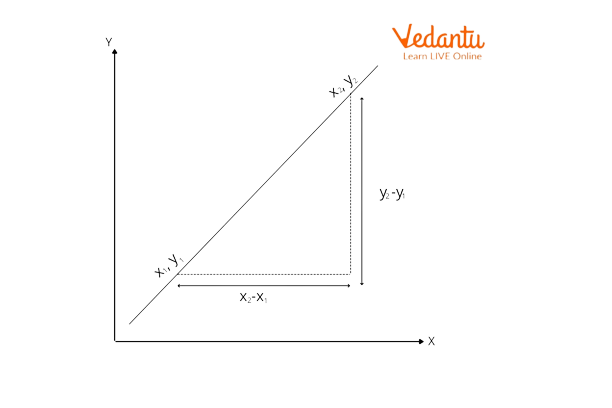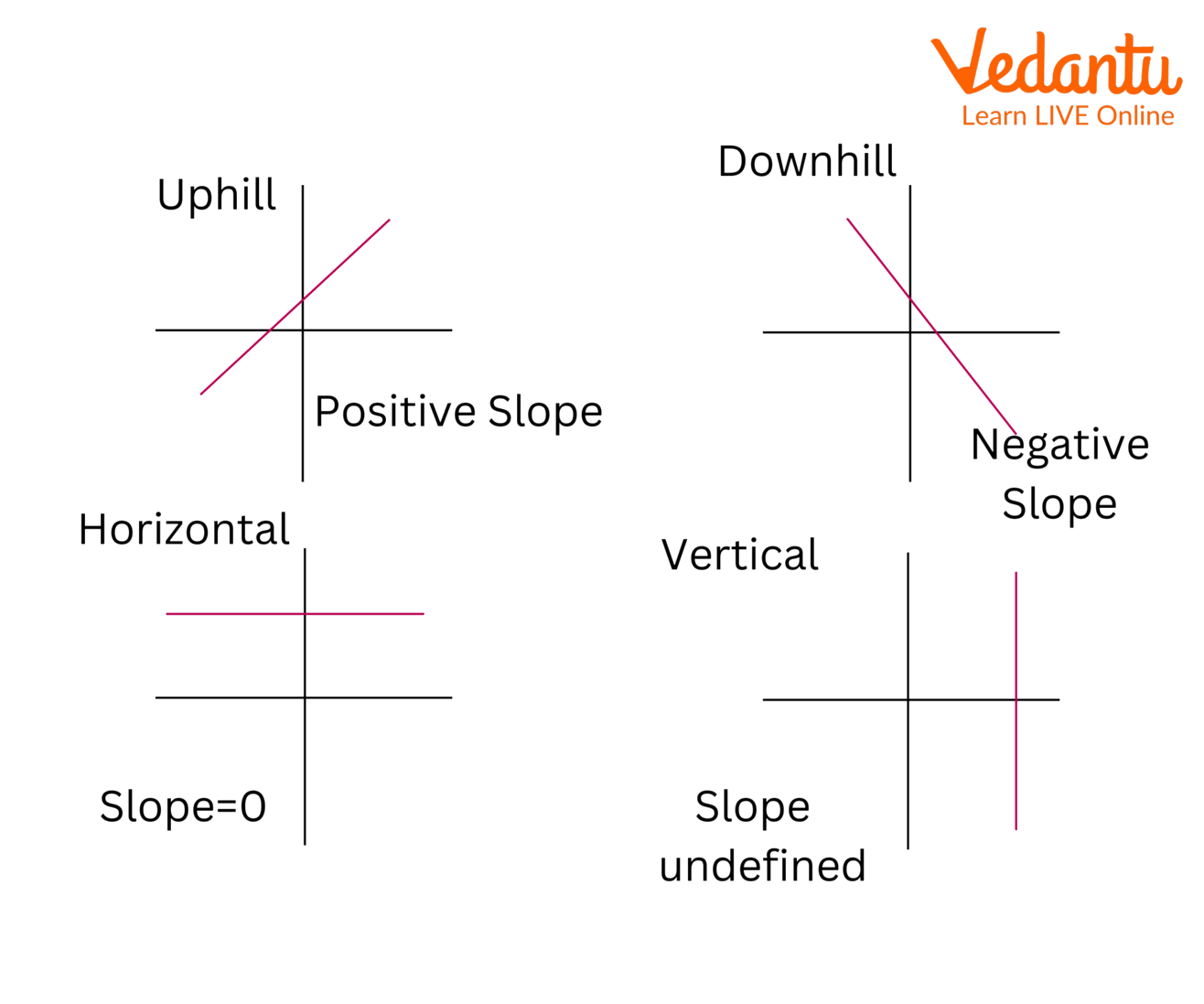




How to Calculate and Apply Angle of Inclination in Physics
The inclination from the x-axis to a line, or slope, on a graph, is measured as the angle of inclination of a slope. Inclined meaning in Physics is used for solving those questions in which a mass or object is sliding from any surface with a slope. This is a measurement of the angle formed between a positive portion of the x-axis travelling counter-clockwise until it touches the slope of the line. It is similar to the measurement of inclination on a graph. If the line's slope is positive, it will pass through the graph's top right quadrant and have an acute angle. If the line has a negative slope, it will go through the top left quadrant and have an obtuse angle.
What is the Angle of Inclination?
On a graph, the distance between two lines is measured by their angle of inclination. This area is typically triangular in form since lines on a graph are frequently drawn at an angle. Since the angles of all triangles are equal, this area between two lines must frequently be expressed by "angles of inclination." Because the angle of inclination and the slope of the line are truly identical, we may utilise it when the slope of a line cannot be calculated in the usual method. The angle of inclination is acute when the slope is positive. The angle of inclination is obtuse when the slope is negative.
Relation between Inclination and Slope
A line's slope on a graph is the ratio of change from the vertical to the horizontal. The letter m is frequently used to symbolise this. A line's slope increases with its steepness. On a graph, a slope that is represented by a negative number indicates that the line is moving downhill rather than upward. The following equation describes the connection between a line's inclination and slope.
\[m = \tan \theta \]
Positive Slope or Negative Slope
How to find the inclination of a line? Let’s suppose we have any line with a coordinate \[({x_1},{y_1})\] and \[({x_2},{y_2})\], then the slope can be calculated as:

Graph Showing Negative Slope
\[m = \dfrac{{{y_2} - {y_1}}}{{{x_2} - {x_1}}}\]
\[\tan \theta = \dfrac{{{y_2} - {y_1}}}{{{x_2} - {x_1}}}\]
From the above two equations, we can say
\[m = \tan \theta \]
If \[\tan \theta \] is greater than zero, then the angle is acute. In this condition, we can say the slope is positive. If \[\tan \theta \] is smaller than zero, then the angle is obtuse. In this condition, we can say the slope is negative. The above equations are used as the angle of inclination formula.
Inclination or Slope of Horizontal Line and Vertical Line
Inclination or Slope of Horizontal Line
We are aware that a horizontal line in a coordinate plane is a straight line that is either drawn from left to right or right to left and is parallel to the x-axis. As a result, there has been zero net change in the y-coordinates of the horizontal line.
For the horizontal line, the slope is zero.
m = 0.
Inclination or Slope of Vertical Line
We are aware that in a coordinate plane, a vertical line is a straight line that is drawn from top to bottom or bottom to top and is parallel to the y-axis. As a result, there has been zero net change in the vertical line's x-coordinates.
For the Vertical line, the slope is undefined.
m = undefined
Different Types of Slope

Positive Slope, Negative Slope, Zero Slope, and Undefined Slope
Interesting Facts
On its axis, the Earth is tilted. The Earth's inclination on its axis refers to this tilting of the planet's axis. Days and nights differ in length in different parts of the Earth as a result of the tilted axis of the planet.
The pitch of a roof is represented by its slope. The roof's pitch impacts how much building material will be required to construct it as well as how effectively it will function. A proper pitch will stop the buildup of water and debris. The roof will effectively slide off water and debris.
Solved Problem
1. Find the angle of inclination of a line when the points of the line are given as (2,3) and (8,9).
Solution:
Given, (2,3) and (8,9)
\[\tan \theta = \dfrac{{{y_2} - {y_1}}}{{{x_2} - {x_1}}}\]
\[\Rightarrow \theta = 135\]
\[\Rightarrow \tan \theta = 1\]
\[\therefore \theta = 45\] degrees.
So, the angle which is made by the angle of inclination is 45 degrees.
2. Find the angle of inclination of a line when the points of the line are given as (3,3) and (9,-3).
Solution:
Given, (3,3) and (9,-3)
\[\tan \theta = \dfrac{{{y_2} - {y_1}}}{{{x_2} - {x_1}}}\]
\[\Rightarrow \tan \theta = \dfrac{{ - 3 - 3}}{{9 - 3}}\]
\[\Rightarrow \tan \theta = - 1\]
\[\therefore \theta = 135\]degrees.
The angle made by the inclined line is 135 degrees.
Summary
The angle of inclination is related to the slope of a line. If any object is placed on an inclined plane, it will start moving due to downward force which is created by the angle of inclination. If we use trigonometric functions, then we can calculate it or we can also use the coordinate point of a line for the calculation. In some natural phenomena, it plays an important role.
FAQs on Angle of Inclination: Key Concepts Explained
1. What is the angle of inclination in Physics and Mathematics?
In mathematics, the angle of inclination is the specific angle a straight line makes with the positive x-axis, measured in a counter-clockwise direction. Its value, θ, always lies between 0° and 180°. In physics, this concept is applied to inclined planes (ramps), where it represents the angle of the sloped surface with respect to the horizontal. This angle is crucial for analysing forces like gravity and friction acting on an object on the ramp.
2. How do you calculate the angle of inclination of a line?
The angle of inclination (θ) is calculated using the slope (m) of the line. The formula that connects them is m = tan θ. If you know the coordinates of two points on the line, (x₁, y₁) and (x₂, y₂), you first find the slope using m = (y₂ - y₁)/(x₂ - x₁). Then, you find the angle by calculating θ = arctan(m) or tan⁻¹(m). The result gives you the angle in degrees or radians.
3. What are some common real-world examples of an angle of inclination?
The angle of inclination appears in many everyday situations. Common examples include:
- Ramps and Wheelchair Access: These are inclined planes designed at a specific angle to make it easier to move objects or people to a higher level.
- Playground Slides: The steepness of a slide is determined by its angle of inclination.
- Roads and Hills: The gradient or steepness of a road on a hill is a practical application of the angle of inclination.
- Staircases: Each step flight forms an inclined plane with a specific angle relative to the floor.
4. What is the angle of inclination for a horizontal line and a vertical line?
The angle of inclination has specific values for these special cases:
- For a horizontal line, which is parallel to the x-axis, the angle of inclination is 0 degrees. This is because it does not form any angle with the positive x-axis.
- For a vertical line, which is perpendicular to the x-axis, the angle of inclination is 90 degrees.
5. How does the angle of inclination relate to the slope of a line?
The angle of inclination (θ) and the slope (m) are intrinsically linked through the trigonometric function tangent. The relationship is defined by the formula m = tan θ. This means the slope of a line is the tangent of its angle of inclination. This connection allows you to determine one value if you know the other. A steeper line has a larger angle of inclination and therefore a larger slope value.
6. What is the difference between the angle of inclination and the angle of elevation?
While both are angles, they are used in different contexts. The angle of inclination specifically measures the angle a line makes with the horizontal x-axis in a coordinate system, measured counter-clockwise. In contrast, the angle of elevation is the angle formed between the horizontal line of sight of an observer and an object that is located above the observer's eye level. It is a term used more in trigonometry and real-world navigation.
7. Why is understanding the angle of inclination important in Physics?
Understanding the angle of inclination is critical in physics, especially in mechanics. When an object is on an inclined plane, its weight (a force due to gravity) must be resolved into two components: one perpendicular to the plane and one parallel to it. The angle of inclination directly determines the magnitude of these components. This is essential for calculating:
- The force causing an object to slide down (parallel component).
- The normal force exerted by the plane (perpendicular component).
- The effect of friction, which opposes the motion along the plane.
8. How does a positive or negative slope affect the angle of inclination?
The sign of the slope directly indicates the type of angle of inclination:
- A positive slope (m > 0) means the line rises from left to right. This results in an acute angle of inclination, where 0° < θ < 90°.
- A negative slope (m < 0) means the line falls from left to right. This results in an obtuse angle of inclination, where 90° < θ < 180°.
A slope of zero corresponds to an angle of 0° (horizontal line), and an undefined slope corresponds to an angle of 90° (vertical line).
9. Besides lines on a graph, where else is the concept of angle of inclination used, for example, with the Earth?
Yes, the concept extends beyond simple graphs. A major example is the Earth's axial tilt, which is its angle of inclination. The Earth's rotational axis is tilted at approximately 23.5 degrees relative to its orbital plane around the Sun. This inclination is not just a fact; it is the primary reason for the changing seasons. As the Earth orbits the Sun, this tilt causes different parts of the planet to receive more direct sunlight at different times of the year, leading to summer and winter.
























